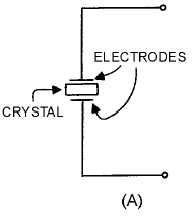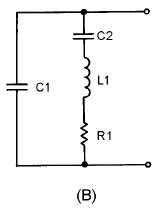2-25
crystal may crack. Overloading the crystal affects the frequency of vibration because the power
dissipation and crystal temperature increase with the amount of load current.
Crystals as Tuned Circuits
A quartz crystal and its equivalent circuit are shown in figure 2-20, views (A) and (B). Capacitor C2,
inductor L1, and resistor R1 in view (B) represent the electrical equivalent of the quartz crystal in view
(A). Capacitance C1 in (view B) represents the capacitance between the crystal electrodes in view (A).
Depending upon the circuit characteristics, the crystal can act as a capacitor, an inductor, a series-tuned
circuit, or a parallel-tuned circuit.
Figure 2-20A.—Quartz crystal and equivalent circuit.
Figure 2-20B.—Quartz crystal and equivalent circuit.
At some frequency, the reactances of equivalent capacitor C1 and inductor L will be equal and the
crystal will act as a series-tuned circuit. A series-tuned circuit has a minimum impedance at resonance
(figure 2-21). Above resonance the series-tuned circuit acts INDUCTIVELY, and below resonance it acts
CAPACITIVELY. In other words, the crystal unit has its lowest impedance at the series-resonance
frequency. The impedance increases as the frequency is lowered because the unit acts as a capacitor. The
impedance of the crystal unit also increases as the frequency is raised above the series-resonant point
because the unit acts as an inductor. Therefore, the crystal unit reacts as a series-tuned circuit.



